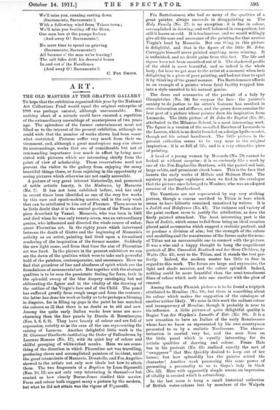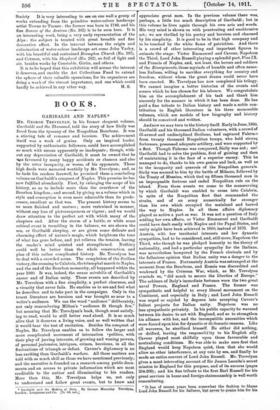ART.
THE OLD MASTERS AT THE GRAFTON GALLERY. To hope that the exhibition organized this year by the National Art Collections Fund would equal the original enterprise of 1909 was perhaps natural, although unreasonable. But nothing short of a miracle could have ensured a repetition of the extraordinary assemblage of masterpieces of two years ago. The splendour of the former entertainment must not blind us to the interest of the present exhibition, although we could wish that the number of works shown had been some- what restricted. Pictures suffer very much from their en- vironment, and, although a great masterpiece may rise above its surroundings, works that are of considerable but not of commanding importance lose much in effect by being asso- ciated with pictures which are interesting chiefly from the point of view of scholarship. These reservations need not prevent the visitor to the gallery from enjoying the many beautiful things there, or from rejoicing in the opportunity of seeing pictures which otherwise are not easily accessible.
A picture of very great interest historically, and possessed of noble artistic beauty, is the Madonna, by Masaccio (No. 7). It has not been exhibited before, and has only in recent times been identified as one of the very few works by this rare and epoch-making master, and is the only work that can be attributed to him out of Florence. There seems to be little doubt that it is the central portion of the Pisan altar- piece described by Vasari. Masaccio, who was born in 1401 and died when he was only twenty-seven, was an extraordinary genius, who influenced and directed the whole course of subse- quent Florentine art. In the eighty years which intervened between the death of Giotto and the beginning of Masaccio's activity as an artist, painting had lived upon a formalized rendering of the inspiration of the former master. Suddenly the new light came, and from that time the aim of Florentine art was fixed. In the picture in the present exhibition we can see the dawn of the qualities which were to take such powerful hold of the painters, contemporaries, and successors. Here we find that grandeur of line and aloofness of spirit which are the foundations of monumental art. But together with the abstract qualities is to be seen the passionate feeling for form, both in the splendid sweep of the blue drapery enveloping but not obliterating the figure and in the vitality of the drawing of the outline of the Virgin's face and of the Child. The panel has suffered greatly from rough usage and from the restorer; the latter has done his work so badly as to be perhaps a blessing in disguise, for in filling up gaps in the paint he has matched the colours so ill that there is no doubt as to old and new. Among the quite early Italian works here none are more charming than the four panels by Duccio di Buoninsegna (Nos. 5, 6, 8, 9). They have beauty of colour and are full of expression, notably so in the case of the one representing the raising of Lazarus. Another delightful little work is the St. Giovanni Gualberto instituting the Order of Vallombrosa, by Lorenzo Monaco (No. 17), with its quiet key of colour and skilful grouping of white-robed monks. Here we see some- thing of the direction in which Florentine art was travelling, producing clever and accomplished painters of incident, until the great triumvirate of Masaccio, Donatello, and Fra Angelico showed to the artists not only new ideals but how to attain them. The two fragments of a Baptism. by Luca Signorelli (Nos. 10, 12) are not only very interesting in themselves but remind us how closely Barne-Jones studied this waster. Form and colour both suggest many a picture by the modern, but what he did not attain was the vigour of Signorelli. Fra Bartolommeo, who had so many of the qualities of a great painter, always succeeds in disappointing us. The Holy Family (No. 27) is no exception : it is fine in colour, accomplished in drawing, and well balanced in composition, but still it leaves us cold. It is too luscious, and we would willingly give all the ease and assurance of the painting for that austere Virgin's head by Masaccio. But one tiling in this picture is delightful, and that is the figure of the little St. John.
Correggio himself never painted anything more winning. It is unfinished, and no doubt gains from this fact. The life and vigour have not been smoothed out of it. The shadowed profile of the child is most beautiful, and so indeed is the whole body ; for here we get near to the artist at a moment when be is delighting in a piece of pure painting, and had not time to spoil it by thinking of the grand manner. Fra Bartolommeo affords us an example of a painter whose fatal facility trapped him into a style unsuited to his natural genius.
The dress and accessories of the portrait of a lady by Gianpietrino (No. 34) far surpass the face : the painter's anxiety to do justice to his sitter's features has resulted in over-elaboration and stiffness, and the green dress remains the best part of a picture whose painter drew his inspiration from Leonardo. The little picture of St. John the Baptist (No. 36), attributed to the Milanese School, is a most interesting work. The figure is a version of the so-called Bacchus of Leonardo in the Louvre, which is no doubtfouuded on a design by the master, though not his actual handiwork. The little picture in the present collection seems to be very near to the original inspiration : it is so full of life, and is a very attractive piece of painting.
A head of a young woman by Morando (No. 79) cannot be looked at without surprise : it is so curiously like a work by one of the Pre-Raphaelite Brethren, with the parted red hair, large orbits, and prominent cheek bones. This is the face that haunts the early works of Millais and Holman Hunt. The mystery is perhaps explained when we find in the catalogue that the picture once belonged to Woolner, who was an adopted member of the Brotherhood.
The Venetians are not represented by any very striking picture, though a canvas ascribed to Titian is here which seems to have hitherto remained unnoticed by writers. It is a Judith and Holofernes (No. 43). The richness and variety of the paint surface seem to justify the attribution, as does the finely painted attendant. The least interesting part is the face of Judith, which seems to fail from being an ideal creation placed amid accessories which suggest a realistic portrait, and so produce a division of aim; but the strength of the colour and modelling and the massiveness of the forms make the name of Titian not an unreasonable one to connect with the picture.
It was a wise and a happy thought to hang the magnificent portrait of Mrs. Cavendish Bentinck and her three Children, by Watts (No. 42), next to the Titian, and it stands the test per- fectly. Indeed, the modern master has little to fear in regard to this work. The forms are large and expressive, the light and shade massive, and the colour splendid. Indeed, nothing could be more beautiful than the semi-translucent films of colour which melt into one another with the glow of enamel.
Among the early Flemish pictures is to be found a triptych attributed to Memlinc (No. 88), but there is something about its colour which makes the suggestion of the catalogue of another author likely. We miss in this work the radiant colour and transparency of Memlinc, though it probably is near to his influence. A little picture of quite delightful quality is Rogier Van der Weyden's Leonello d' Este (No. 90). It is a new sensation to have an Italian of the early Renaissance whose face we know as represented by his own countrymen presented to us by a realistic Northerner. The charac- terization is carried very far, and the man lives on the little panel which is equally interesting for its artistic qualities of drawing and colour. Frans Hale has in his portrait (No. 65) realized exactly the sort of " swaggerer " that Mrs. Quickly desired to keep out of her house; but how splendidly has the painter seized the character! Another work possessing this same power of presenting a personality to us is Goya 's lady in black (No. 52). Here with apparently simple means an impression of vitality is created which is astonishing.
In the last room is hung a small historical collection of British water-colours lent by members of the Walpole
Society It is very interesting to see on one wall a group of works extending from the primitive water-colour landscape artist Towne to Turner : the former was born in 1740, and his fine Source of the Arviron (No. 162) is to be seen here. It is an interesting work, being a very early representation of the Alps : the subject is treated with great breadth and fine decorative effect. In the interval between the origin and culmination of water-colour landscape art come John Varley, with his beautiful and restrained Brampton Church (No. 197), and Cotman, with his Shepherd (No. 202), so full of light and air, besides works by Constable, Girtin, and others.
It is to be hoped that this exhibition will arouse the interest it deserves, and enable the Art Collections Fund to extend the sphere of their valuable operations, for its organizers are doing a work of the utmost importance, and one which could
hardly be achieved in any other way. H. S.



















































 Previous page
Previous page